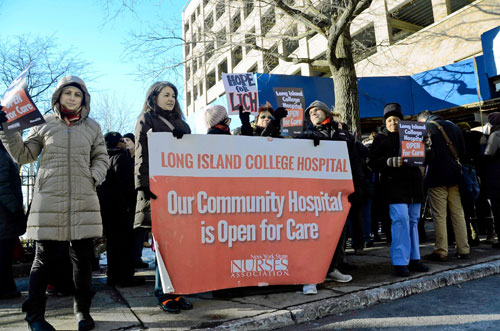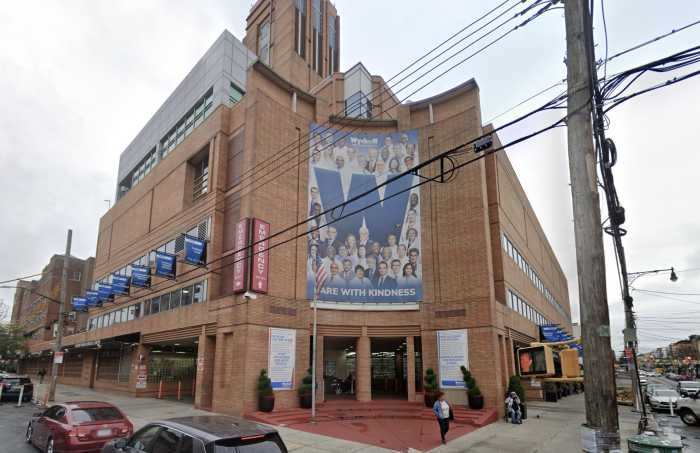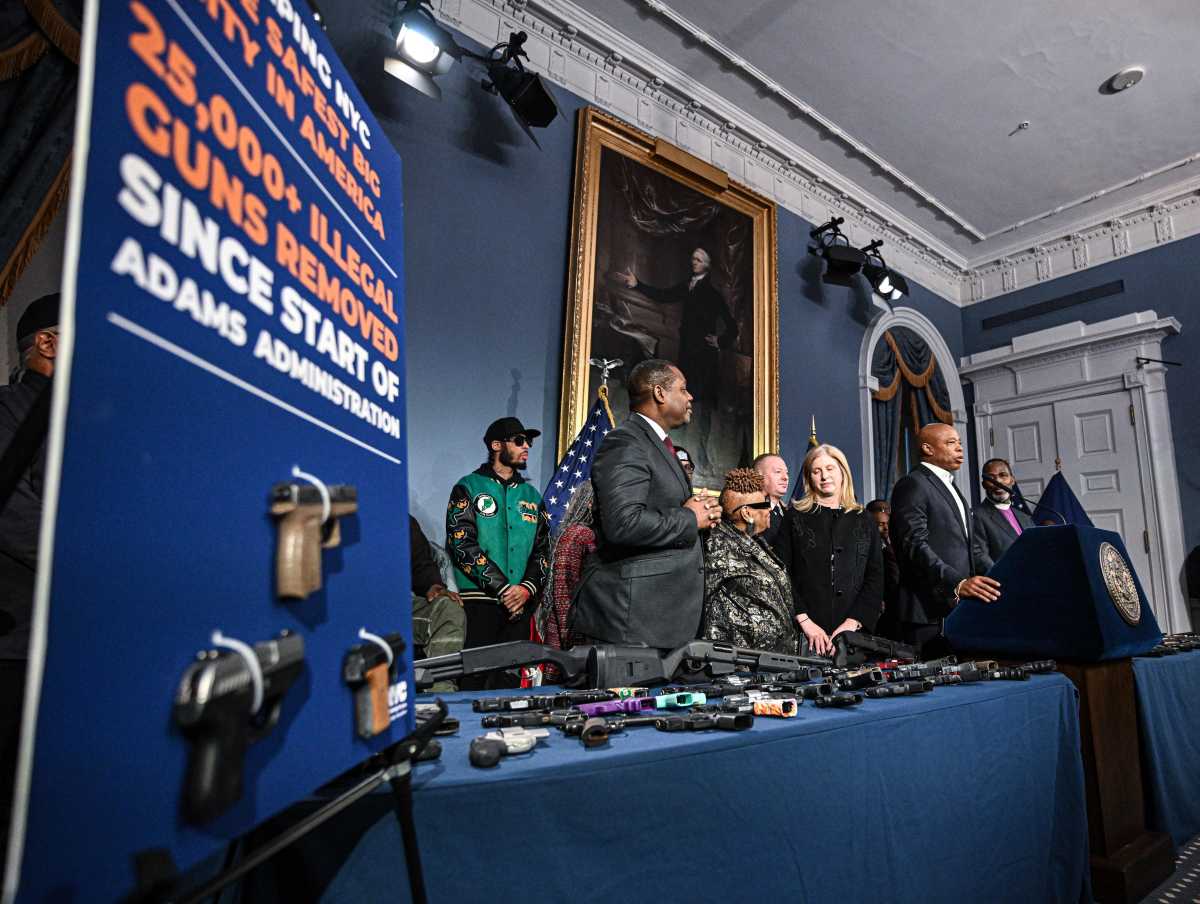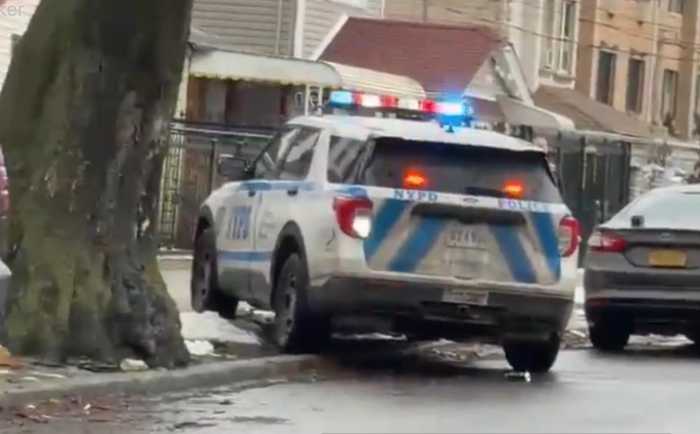The emergency room inside the medical campus formerly known as Long Island College Hospital became New York University Langone Medical Center Cobble Hill on Oct. 31. The changing of the signs out front marked an anticlimactic end of a once-proud institution. For a glimpse of what Brooklyn has lost in the closing of Long Island College Hospital to make way for luxury housing, here’s a look back at the hospital’s history.
1858: Long Island College Hospital opens to great fanfare as the first teaching hospital in Brooklyn. The opening ceremony is presided over by high society types, including railroad baron Samuel Sloan.
In his speech, Sloan describes the hospital site as “an exceedingly elegant and salubrious location.”
“Here the unfortunate, the friendless, and the destitute will find a home when afflicted by sickness,” Sloan says.
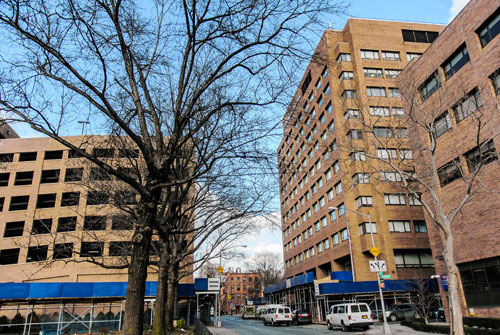
1860: The medical college opens after early stumbles. It is the first U.S. medical school to employ bedside teaching, a technique that would later be adopted throughout the country.
1863: With the Civil War in full swing, the hospital begins service as a Union Army medical base.
1873: Hospital directors establish Brooklyn’s first ambulance service. By this time, hospital doctors are seeing more than 10,000 patients per year.
1875: The medical college tasks students with cutting open cadavers for a hands-on lesson in anatomy. It is the first appearance in an American curriculum of the grisly schoolwork.
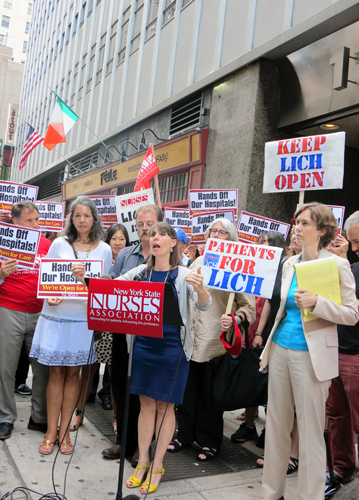
1888: A hospital regent establishes a laboratory for a new and fast-growing area of study: infectious diseases.
1897: Construction finishes on the hospital’s eight-story Polhemus Memorial Clinic, which is possibly the first high-rise hospital in the world. After a fire at Ellis Island, hospital officials sign an agreement with the federal government to treat sick immigrants arriving at the Port of New York.
1914: The hospital establishes an anesthesia training program, the fourth in the U.S.
1915: A new wing boosts the hospital’s capacity to 500 beds.

1932: Viennese psychiatrist Alfred Adler joins the staff as a visiting psychologist shortly after coining the term “inferiority complex.”
1950s: The hospital inaugurates first hospital-based training for nurse-midwives.
1954: The medical college merges with the State University of New York.
Long Island College Hospital spends much of the latter half of the 20th century as a premier urban medical complex, housing some 60 clinics and delivering thousands of Brooklyn’s babies. But by the 1990s, the hospital has fallen on hard times. The budget battles that have raged over the last 15 years have had as many twists and turns as a lower intestine. Here’s a brief run-down:
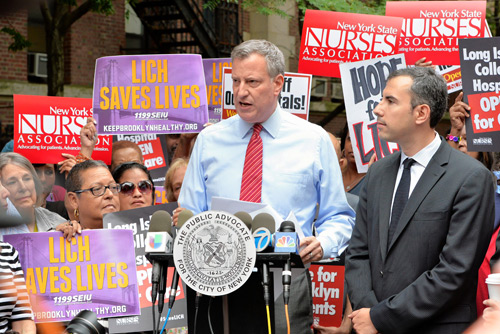
1998: Burdened with declining revenues, the hospital is taken over by Continuum Health Partners, a Manhattan-based management group.
2007: Continuum sells the historic limestone and brick building that housed its child neurology clinic. At the year’s end, hospital bookkeepers are looking at $21.7 million in losses.
2008: Continuum unloads three more hospital buildings for more than $33 million. The sale isn’t enough to staunch the financial bleeding. By mid-year, hospital administrators announce the closing of sex abuse and psychiatric programs. Management lays off some 100 staffers and the hospital’s president and CEO resigns.
2010: The hospital announces a merger with SUNY Downstate Medical Center as part of a bailout plan by then-Gov. David Paterson. Despite this, the year ends with $32 million in losses.

2011: Gov. Andrew Cuomo withholds, then releases $62 million in state grants promised by his predecessor, Paterson, to save the hospital. The state closes the hospital nursing school with six weeks notice, leaving dozens of medical students in the lurch.
2012: Management lays off 150 hospital workers.
June 2013: State University of New York administrators shut the emergency room to ambulances. The move prompts a judge to rule that management is in contempt for violating a temporary restraining order prohibiting the hospital’s closure. Doctors, nurses, and former patients rally in protest.
Late July 2013: The State Department of Health approves parts of the state’s plan to close the hospital, telling hospital staff they’ll get 30 days notice before being firedAugust 2013: Brooklyn Supreme Court Judge Carolyn Demarest snatches the hospital from state control, ruling that State University officials may have taken over the hospital in a bad-faith scheme to shutter it and unload the real estate it sits on, and that they could no longer be trusted to manage it. The state maintains control as previous operator Continuum declines to take over, and state managers ignore a separate court order mandating that they restore ambulance service.

September 2013: The state restores ambulances after two and a half months and Demarest demands that it bring back full hospital services and account for the $140-million Othmer Endowment, which was supposed to keep the hospital running forever, but which state officials admitted borrowing from. Baynes rules that the closure was unconstitutional, but puts off a ruling on whether university honchos were in contempt of court for ignoring multiple judicial directives. He would do so numerous times and ultimately never decide the issue.
December 2013: University board members put off a vote on whether to sell the hospital to a luxury developer and offers to give Mayor-Elect Bill DeBlasio’s administration the keys. The Hizzoner-to-be, who got arrested protesting the closure in the run-up to the election, never responded.February 2014: The state reveals five redevelopment proposals for the medical center, none of which include a full-service hospital. Faced with continued legal pressure from activists and staffers, it then reaches a settlement to reopen the bidding process and give preference to plans that keep the hospital open. In the process, it announces a May deadline when it will walk away from operating the facility for good. Mayor DeBlasio calls the settlement “truly historic, a transcendent moment for healthcare.”
March 2014: Four of nine new redevelopment proposals call for keeping the hospital a hospital. Among the others is a bid from developer Fortis Property Group, the president of which gave donated to Gov. Cuomo’s reelection campaign along with his uncle, who is not a partner in the firm. Cuomo controls the State University’s board, and thus, the hospital’s fate.
April 2014: The group Brooklyn Health Partners wins with a proposal that includes a full-service hospital.
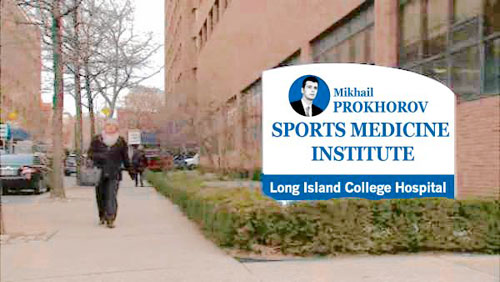
Early May 2014: The state nixes negotiations with Brooklyn Health Partners. The developer claims state sabotage, but the torch passes to luxury developer Peebles Corporation, which has political ties to State University chairman H. Carl McCall. It did not include a hospital in its plan.
May 15, 2014: The state bars ambulances from the hospital again.
May 22, 2014: The hospital closes for good as Peebles agrees to maintain the emergency department, which critics argue is a glorified urgent-care clinic.
May 28, 2014: The state gives Peebles the boot, saying it moved the ball on what kinds of healthcare would be provided at a new medical facility and who would pay for a potentially costly environmental cleanup. Activists argue that state officials wanted next-in-line Fortis all along. The state continues operating the emergency department for walk-in patients.

June 2014: The state clinches its deal with Fortis and New York University Langone Medical Center, selling the medical campus valued at as much as $500 million for $240 million.
August 2014: Staffers unions sue once more in a last-ditch effort to get former hospital workers rehired at the planned smaller medical complex on the site, as mandated by the settlement.
September 2014: New York University ducks out of the deal, citing the new lawsuit, then gets back on board when Baynes throws it out. The court reversal followed a threat by McCall to shutter the emergency room for good.
Oct. 30, 2014: Attorney General Eric Schneiderman and state Comptroller Tom DiNapoli sign off on the Fortis sale, giving it the final go-ahead.

Oct. 31, 2014: New York University takes over operation of the emergency department and the state pledges that ambulances will return “as soon as possible.”Editor’s note: This is an updated version of an earlier Long Island College Hospital timeline. To compare and see how much has happened since July of 2013, click here.



